Measuring the Degree of Balance between Urban and Tourism Development: An Analytical Approach Using Cellular Data
Abstract
:1. Introduction
2. Literature Review
2.1. Measuring the Degree of Balance between Urban Development and Tourism Planning: Previous Attempts and Difficulties
2.2. New Research Potentials Generated from Emerging Multi-Sourced Urban Data
3. Materials and Methods
3.1. Research Questions and Framework
- (1)
- How can the degree of “balance” in urban areas based on the dispersal of human flow be evaluated?
- (2)
- How do different categories of urban features affect balanced urban development?
3.2. Research Cases
3.3. Cellular Data Processing
- (1)
- First, we classified the local and non-local IDs at the scale of the whole Shanghai city. Those IDs which consistently stayed in the Shanghai at night were regarded as residents of Shanghai. IDs that travelled for outside to Shanghai were considered to be non-local visitors.
- (2)
- Then, we identified the residential, working, and recreational places for each resident of Shanghai. The location where one ID stayed between 8:00 p.m. and 8:00 a.m. over a period of more than seven days was marked as the “home” of this ID. Correspondingly, where one ID stayed between 8:00 a.m.–8:00 p.m. for over seven days was identified as the place where this ID works. Beyond the residential and working place, the rest place where one ID spent most time was identified as the day’s place of “recreation.” Figure 4 shows a series of trips and places visited for one local ID. Nanjingxi Road Historical Area could be identified as his or her place of recreation on one weekday.
- (3)
- Based on that, the four kinds of people related to the 33 historical conservation sites, i.e., local residents, local commuters, local tourists, and non-local tourists, were identified. Specifically, the local residents and local commuters are the IDs obtaining residential and working places in these historical conservation sites, respectively. The local tourists are the IDs obtaining recreational places in the sites. The non-local tourists are non-local visitors spending at least three hours in the sites.
- (4)
- With the help of ArcGIS, we were able to identify the number of people within 33 historical conservation sites. Specifically, the numbers of local residents, local commuters, local tourist, and non-local tourists were derived for each site. According to the proportion of residents, commuters, and tourists, the degree of balance of urban and tourism development among these historical conservation areas can be measured.
3.4. Visualizing the Degree of Balance among Different Historical Conservation Areas
3.5. Detecting Contributing Features to the “Degree of Balance” through Statistical Analysis
3.5.1. Independent Variables Related to Urban Development
3.5.2. Multinomial Logistic Regression (MLR)
4. Results
4.1. Ternary Graphs as a Tool to Classify the Balanced Degrees for Urban Historical Conservation Areas
4.2. Multinomial Logistic Regression (MLR) Classification
5. Discussion
5.1. A New Perspective for Measuring the Degree of Balance between Urban Development and Tourism Planning
5.2. Urban Management Implications towards Balanced Development for Historical Conservation Area
5.3. Large-Scale Analysis with a Human-Perspective: Advantages Based on Cellular Data
5.4. Limitations and Future Steps
6. Conclusions
Author Contributions
Funding
Institutional Review Board Statement
Informed Consent Statement
Acknowledgments
Conflicts of Interest
Appendix A
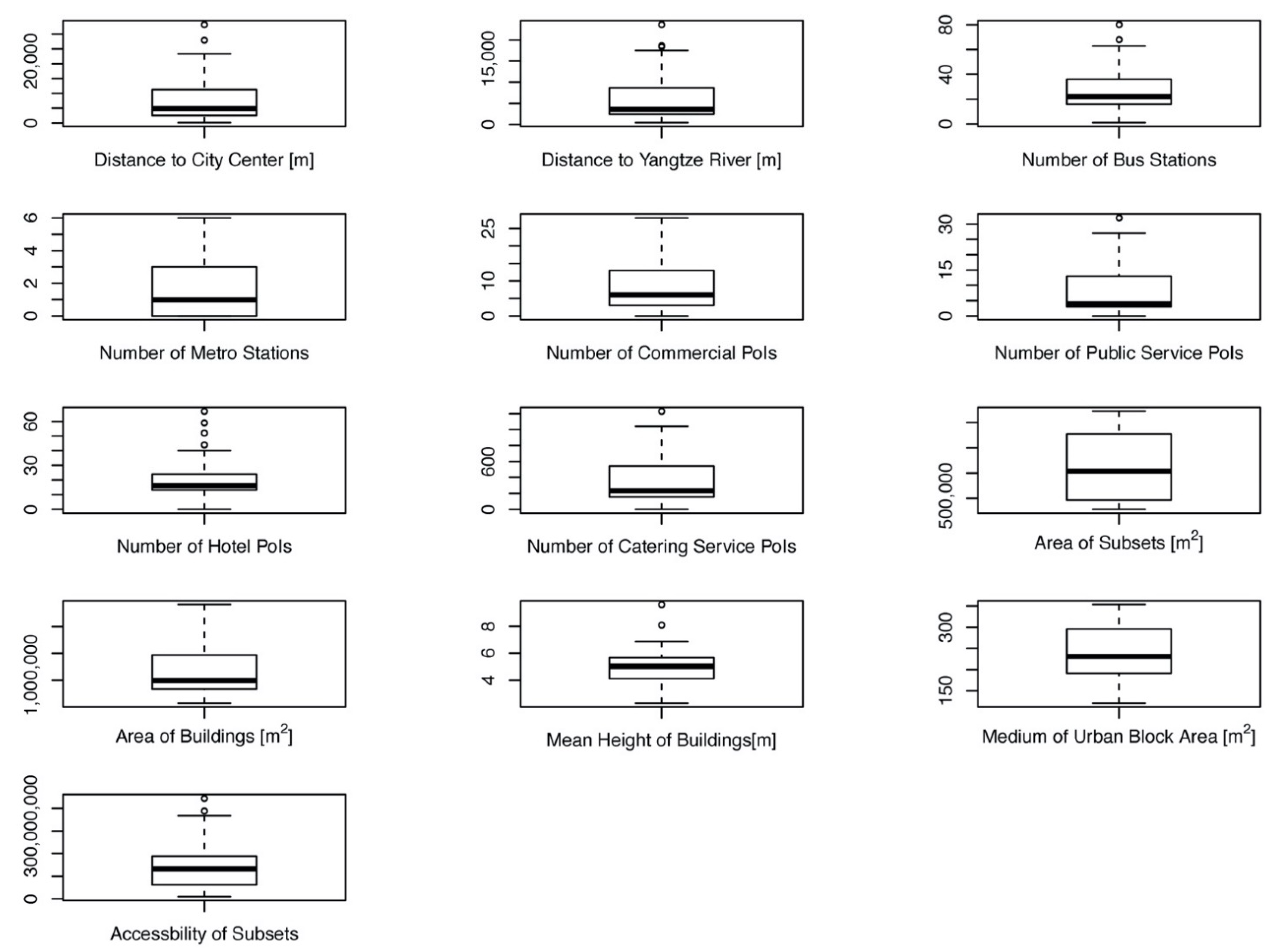
References
- Brida, J.G.; Cortes-Jimenez, I.; Pulina, M. Has the tourism-led growth hypothesis been validated? A literature review. Curr. Issues Tour. 2016, 19, 394–430. [Google Scholar] [CrossRef]
- Perles-Ribes, J.F.; Ramón-Rodríguez, A.B.; Rubia, A.; Moreno-Izquierdo, L. Is the tourism-led growth hypothesis valid after the global economic and financial crisis? The case of Spain 1957–2014. Tour. Manag. 2017, 61, 96–109. [Google Scholar] [CrossRef]
- Diedrich, A.; García-Buades, E. Local perceptions of tourism as indicators of destination decline. Tour. Manag. 2009, 30, 512–521. [Google Scholar] [CrossRef]
- Haley, A.J.; Snaith, T.; Miller, G. The social impacts of tourism a case study of Bath, UK. Ann. Tour. Res. 2005, 32, 647–668. [Google Scholar] [CrossRef] [Green Version]
- Koens, K.; Postma, A. Understanding and Managing Visitor Pressure in Urban Tourism; A Study to into the Nature of and Methods Used to Manage Visitor Pressure in Six Major European, Cities; Breda University of Applied Sciences: Breda, The Netherlands; NHL Stenden University of Applied Sciences: Leeuwarden, The Netherlands, 2017. [Google Scholar]
- United Nations World Tourism Organization (UNWTO). ‘Overtourism’? Understanding and Managing Urban Tourism Growth beyond Perceptions; UNWTO: Madrid, Spain, 2018. [Google Scholar]
- Qian, J.; Feng, D.; Zhu, H. Tourism-driven urbanization in China’s small town development: A case study of Zhapo Town, 1986–2003. Habitat Int. 2012, 36, 152–160. [Google Scholar] [CrossRef]
- Moisey, R.N.; McCool, S.F. Sustainable tourism in the 21st century: Lessons from the past; challenges to address. In Tourism, Recreation and Sustainability: Linking Culture and the Environment; CABI: Wallingford, UK, 2001; pp. 343–352. [Google Scholar]
- Liu, Z. Sustainable tourism development: A critique. J. Sustain. Tour. 2003, 11, 459–475. [Google Scholar] [CrossRef] [Green Version]
- Shoval, N.; Ahas, R. The use of tracking technologies in tourism research: The first decade. Tour. Geogr. 2016, 18, 587–606. [Google Scholar] [CrossRef]
- Li, Y.; Xiao, L.; Ye, Y.; Xu, W.; Law, A. Understanding tourist space at a historic site through space syntax analysis: The case of Gulangyu, China. Tour. Manag. 2016, 52, 30–43. [Google Scholar] [CrossRef]
- Faulkner, B.; Tideswell, C. A framework for monitoring community impacts of tourism. J. Sustain. Tour. 1997, 5, 3–28. [Google Scholar] [CrossRef]
- Postma, A.; Schmuecker, D. Understanding and overcoming negative impacts of tourism in city destinations: Conceptual model and strategic framework. J. Tour. Futures 2017, 3, 144–156. [Google Scholar] [CrossRef]
- Cros, H.D. Too much of a good thing? Visitor congestion management issues for popular world heritage tourist attractions. J. Herit. Tour. 2008, 2, 225–238. [Google Scholar] [CrossRef]
- Kearsley, G.; Coughlan, D. Coping with crowding: Tourist displacement in the New Zealand backcountry. Curr. Issues Tour. 1999, 2, 197–210. [Google Scholar] [CrossRef]
- Eurostat. Feasibility Study on the Use of Mobile Positioning Data for Tourism Statistics. Available online: http://mobfs.positium.ee/ (accessed on 25 August 2021).
- Waligo, V.M.; Clarke, J.; Hawkins, R. Implementing sustainable tourism: A multi-stakeholder involvement management framework. Tour. Manag. 2013, 36, 342–353. [Google Scholar] [CrossRef] [Green Version]
- Moyle, B.D.; Weiler, B.; Croy, G. Visitors’ perceptions of tourism impacts: Bruny and Magnetic Islands, Australia. J. Travel Res. 2013, 52, 392–406. [Google Scholar] [CrossRef] [Green Version]
- Batty, M. The New Science of Cities; MIT Press: Cambridge, MA, USA, 2013. [Google Scholar]
- Batista e Silva, F.; Herrera, M.A.M.; Rosina, K.; Barranco, R.R.; Freire, S.; Schiavina, M. Analysing spatiotemporal patterns of tourism in Europe at high-resolution with conventional and big data sources. Tour. Manag. 2018, 68, 101–115. [Google Scholar] [CrossRef]
- Long, Y.; Ye, Y. Measuring human-scale urban form and its performance. Landsc. Urban Plan. 2019, 191, 103659. [Google Scholar] [CrossRef]
- Ye, Y.; Richards, D.; Lu, Y.; Song, X.; Zhuang, Y.; Zeng, W.; Zhong, T. Measuring daily accessed street greenery: A human-scale approach for informing better urban planning practices. Landsc. Urban Plan. 2019, 191, 103434. [Google Scholar] [CrossRef]
- Hawelka, B.; Sitko, I.; Beinat, E.; Sobolevsky, S.; Kazakopoulos, P.; Ratti, C. Geo-located Twitter as proxy for global mobility patterns. Cartogr. Geogr. Inf. Sci. 2014, 41, 260–271. [Google Scholar] [CrossRef] [PubMed] [Green Version]
- Li, X.; Pan, B.; Law, R.; Huang, X. Forecasting tourism demand with composite search index. Tour. Manag. 2017, 59, 57–66. [Google Scholar] [CrossRef]
- Shoval, N. Tracking technologies and urban analysis. Cities 2008, 25, 21–28. [Google Scholar] [CrossRef]
- Edwards, D.; Griffin, T. Understanding tourists’ spatial behaviour: GPS tracking as an aid to sustainable destination management. J. Sustain. Tour. 2013, 21, 580–595. [Google Scholar] [CrossRef]
- Ratti, C.; Williams, S.; Frenchman, D.; Pulselli, R. Mobile landscapes: Using location data from cell phones for urban analysis. Environ. Plan. B Plan. Des. 2006, 33, 727–748. [Google Scholar] [CrossRef]
- De Nadai, M.; Staiano, J.; Larcher, R.; Sebe, N.; Quercia, D.; Lepri, B. The death and life of great Italian cities: A mobile phone data perspective. In Proceedings of the 25th International Conference on World Wide Web, Montreal, QC, Canada, 11–15 April 2016; pp. 413–423. [Google Scholar]
- Li, Y.; Yang, L.; Shen, H.; Wu, Z. Modeling intra-destination travel behavior of tourists through spatio-temporal analysis. J. Destin. Mark. Manag. 2019, 11, 260–269. [Google Scholar] [CrossRef]
- Ahas, R.; Aasa, A.; Roose, A.; Mark, Ü.; Silm, S. Evaluating passive mobile positioning data for tourism surveys: An Estonian case study. Tour. Manag. 2008, 29, 469–486. [Google Scholar] [CrossRef]
- Furletti, B.; Gabrielli, L.; Renso, C.; Rinzivillo, S. August. Identifying users profiles from mobile calls habits. In Proceedings of the 18th ACM SIGKDD International Workshop on Urban Computing, Beijing, China, 12–16 August 2012; pp. 17–24. [Google Scholar]
- Zhu, X.; Sun, T.; Yuan, H.; Hu, Z.; Miao, J. Exploring group movement pattern through cellular data: A case study of tourists in hainan. Int. J. Geo-Inf. 2019, 8, 74. [Google Scholar] [CrossRef] [Green Version]
- Raun, J.; Ahas, R.; Tiru, M. Measuring tourism destinations using mobile tracking data. Tour. Manag. 2016, 57, 202–212. [Google Scholar] [CrossRef]
- Zhao, X.; Lu, X.; Liu, Y.; Lin, J.; An, J. Tourist movement patterns understanding from the perspective of travel party size using mobile tracking data: A case study of Xi’an, China. Tour. Manag. 2018, 69, 368–383. [Google Scholar] [CrossRef]
- Shanghai Government. Shanghai Tourism Annual Revenue Exceeded 500 Billion Yuan. Shanghai Government. 2019. Available online: http://www.gov.cn/xinwen/2019-03/14/content_5373610.htm (accessed on 15 July 2021).
- Shanghai Resources Bureau. List and Introduction of 44 Historical Conservation Areas in Shanghai. Shanghai Resources Bureau. 2015. Available online: http://ghzyj.sh.gov.cn/bxzc/zsc/lsfm/lsjz/201710/t20171031_737220.html (accessed on 15 July 2021).
- China Mobile. China Mobile Annual Report [Online]. Available online: https://www.chinamobileltd.com/tc/ir/reports/ar2019.pdf (accessed on 15 July 2021).
- Philip, G.M.; Skilbeck, C.G.; Watson, D.F. Algebraic dispersion fields on ternary diagrams. Math. Geol. 1987, 19, 171–181. [Google Scholar] [CrossRef]
- Ye, Y.; Van Nes, A. Quantitative tools in urban morphology: Combining space syntax, spacematrix and mixed-use index in a GIS framework. Urban Morphol. 2014, 18, 97–118. [Google Scholar]
- Li, Y.; Xie, C.; Wang, Q. Research on tourism spatial behavior conflict evaluation and spatial optimization strategy. Geogr. Geo-Inf. Sci. 2018, 34, 92–97. (In Chinese) [Google Scholar] [CrossRef]
- Margolis, J. Municipal fiscal structure in a metropolitan region. J. Polit. Econ. 1957, 65, 225–236. [Google Scholar] [CrossRef]
- Cervero, R. Jobs-housing balancing and regional mobility. J. Am. Plan. Assoc. 1989, 55, 136–150. [Google Scholar] [CrossRef]
- Rosen, S. Hedonic prices and implicit markets: Product differentiation in pure competition. J. Polit. Econ. 1974, 82, 34–55. [Google Scholar] [CrossRef]
- Le-Klaehn, D.T.; Hall, C.M. Tourist use of public transport at destinations—A review. Curr. Issues Tour. 2015, 18, 785–803. [Google Scholar] [CrossRef]
- Hillier, B.; Iida, S. Network and psychological effects in urban movement. In Proceedings of the 5th International Conference on Spatial Information Theory, Bay, CA, USA, 19–23 September 2001; Springer: Berlin, Germany, 2005; pp. 475–490. [Google Scholar]
- Al Sayed, K.; Turner, A.; Hillier, B.; Iida, S.; Penn, A. Space Syntax methodology; Bartlett School of Architecture, UCL: London, UK, 2014. [Google Scholar]
- Ripley, B.; Venables, W.; Ripley, M.B. Package ‘nnet’; R Package Version 7.3-12. 2016. Available online: https://cran.microsoft.com/snapshot/2016-08-05/web/packages/nnet/index.html (accessed on 25 August 2021).
- Al-Hagla, K.S. Sustainable urban development in historical areas using the tourist trail approach: A case study of the Cultural Heritage and Urban Development (CHUD) project in Saida, Lebanon. Cities 2010, 27, 234–248. [Google Scholar] [CrossRef]
- Zhang, L.; Chiaradia, A.; Zhuang, Y. A configurational accessibility study of road and metro network in Shanghai, China. In Recent Developments in Chinese Urban Planning; Springer: Cham, Switzerland, 2015; pp. 219–245. [Google Scholar]
- Pan, H.; Zhang, M. Rail transit impacts on land use: Evidence from Shanghai, China. Transp. Res. Rec. 2008, 2048, 16–25. [Google Scholar] [CrossRef]
- Ding, C. Building height restrictions, land development and economic costs. Land Use Policy 2013, 30, 485–495. [Google Scholar] [CrossRef]
- Ye, Y.; Li, D.; Liu, X. How block density and typology affect urban vitality: An exploratory analysis in Shenzhen, China. Urban Geogr. 2018, 39, 631–652. [Google Scholar] [CrossRef]
- McKercher, B.; Shoval, N.; Ng, E.; Birenboim, A. First and repeat visitor behaviour: GPS tracking and GIS analysis in Hong Kong. Tour. Geogr. 2012, 14, 147–161. [Google Scholar] [CrossRef]
- Shoval, N.; McKercher, B.; Ng, E.; Birenboim, A. Hotel location and tourist activity in cities. Ann. Tour. Res. 2011, 38, 1594–1612. [Google Scholar] [CrossRef]
- Brown, G. Mapping landscape values and development preferences: A method for tourism and residential development planning. Int. J. Tour. Res. 2006, 8, 101–113. [Google Scholar] [CrossRef]
- Paraskevopoulos, P.; Dinh, T.C.; Dashdorj, Z.; Palpanas, T.; Serafini, L. Identification and Characterization of Human Behavior Patterns from Mobile Phone Data. In Proceedings of the NetMob D4D Challenge Session, Cambridge, MA, USA, 1–3 May 2013. [Google Scholar]
- Su, X.; Spierings, B.; Hooimeijer, P.; Scheider, S. Where day trippers and tourists go: Comparing the spatio-temporal distribution of Mainland Chinese visitors in Hong Kong using Weibo data. Asia Pac. J. Tour. Res. 2020, 25, 505–523. [Google Scholar] [CrossRef]
- Grassini, L.; Dugheri, G. Mobile phone data and tourism statistics: A broken promise? Natl. Account. Rev. 2021, 3, 50–68. [Google Scholar] [CrossRef]
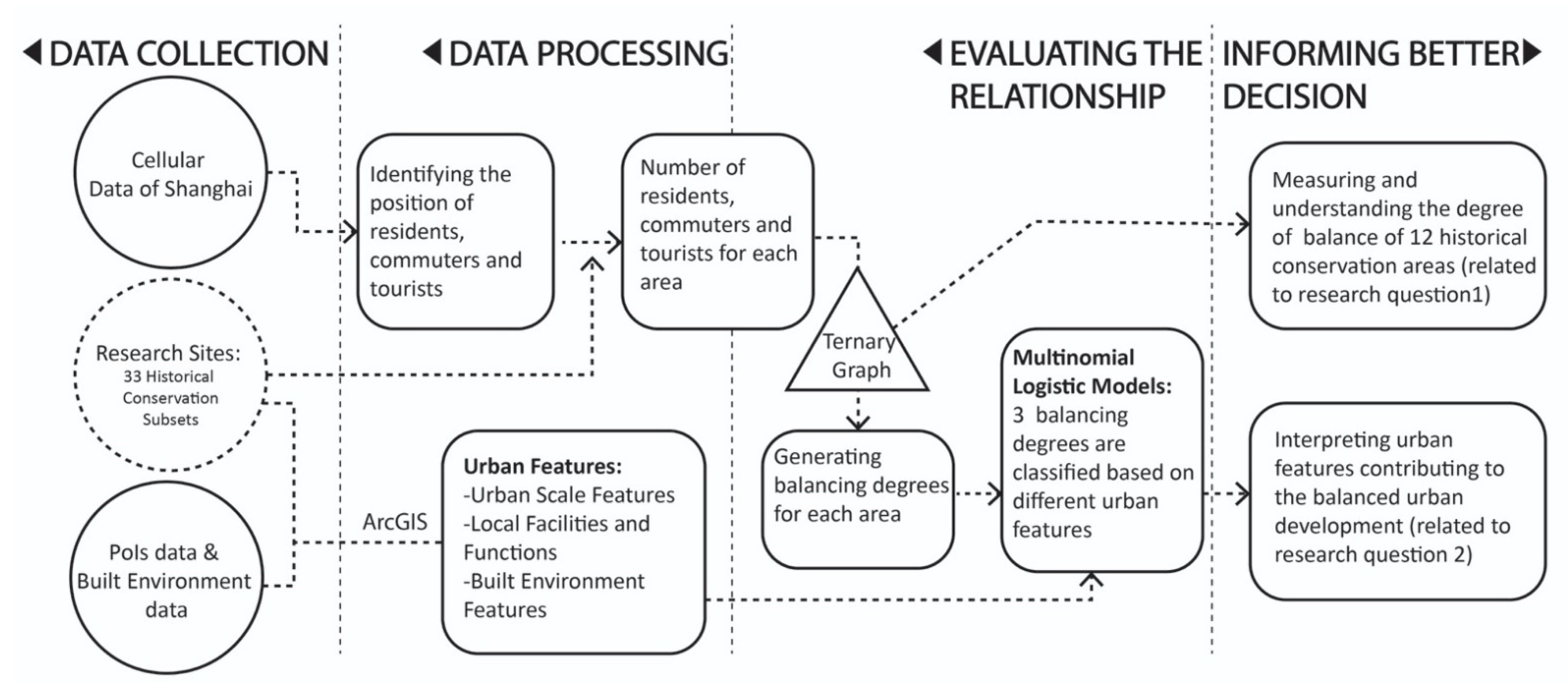
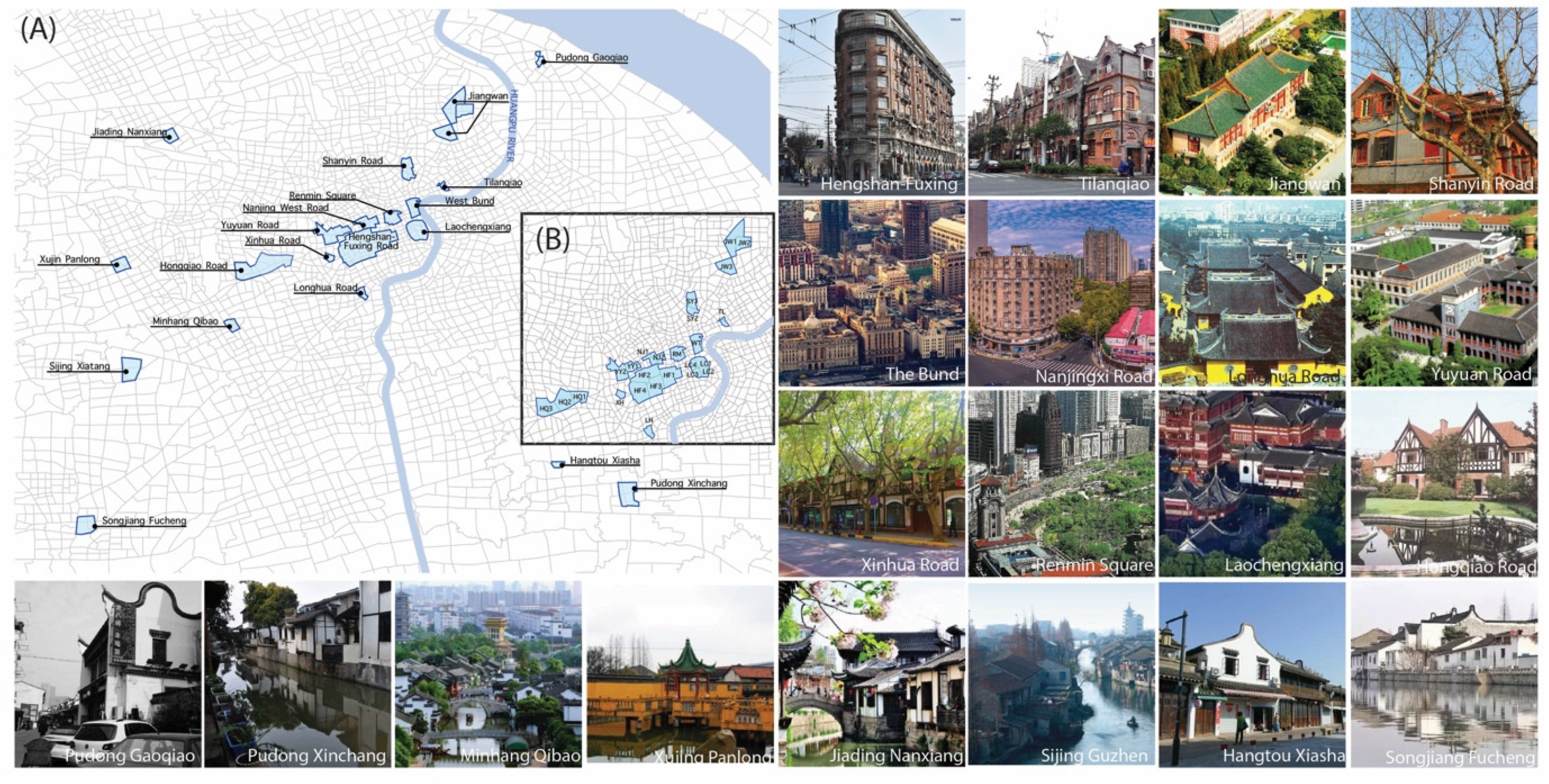
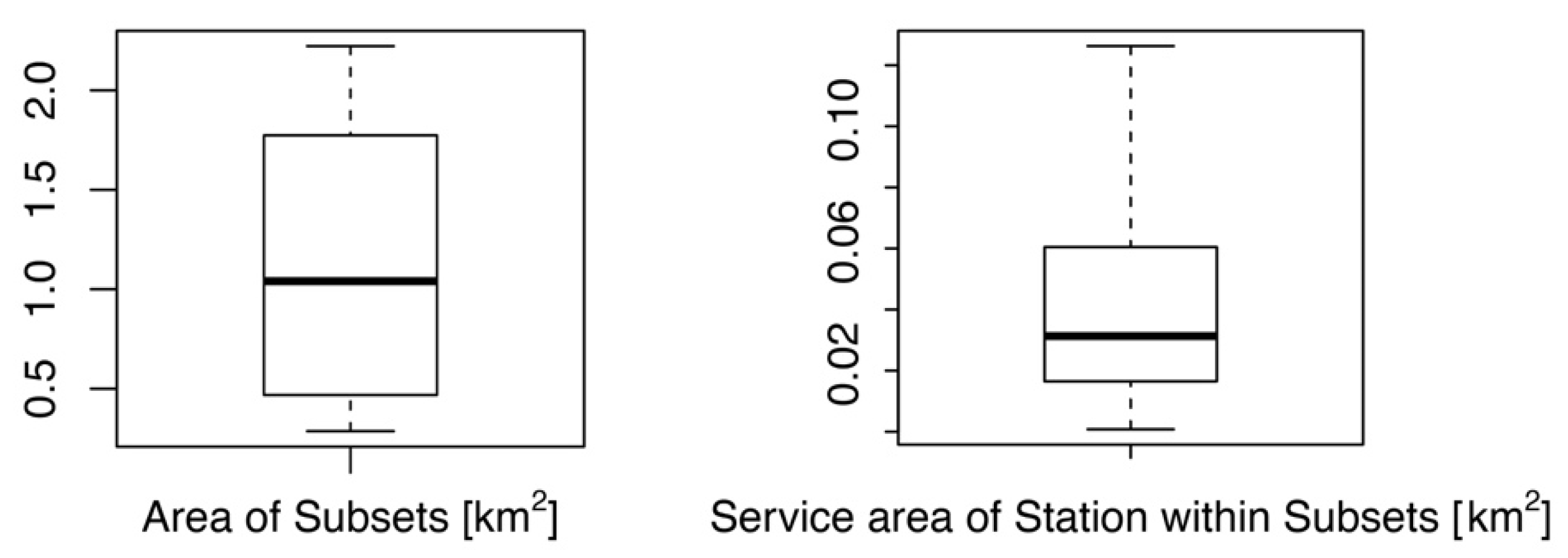

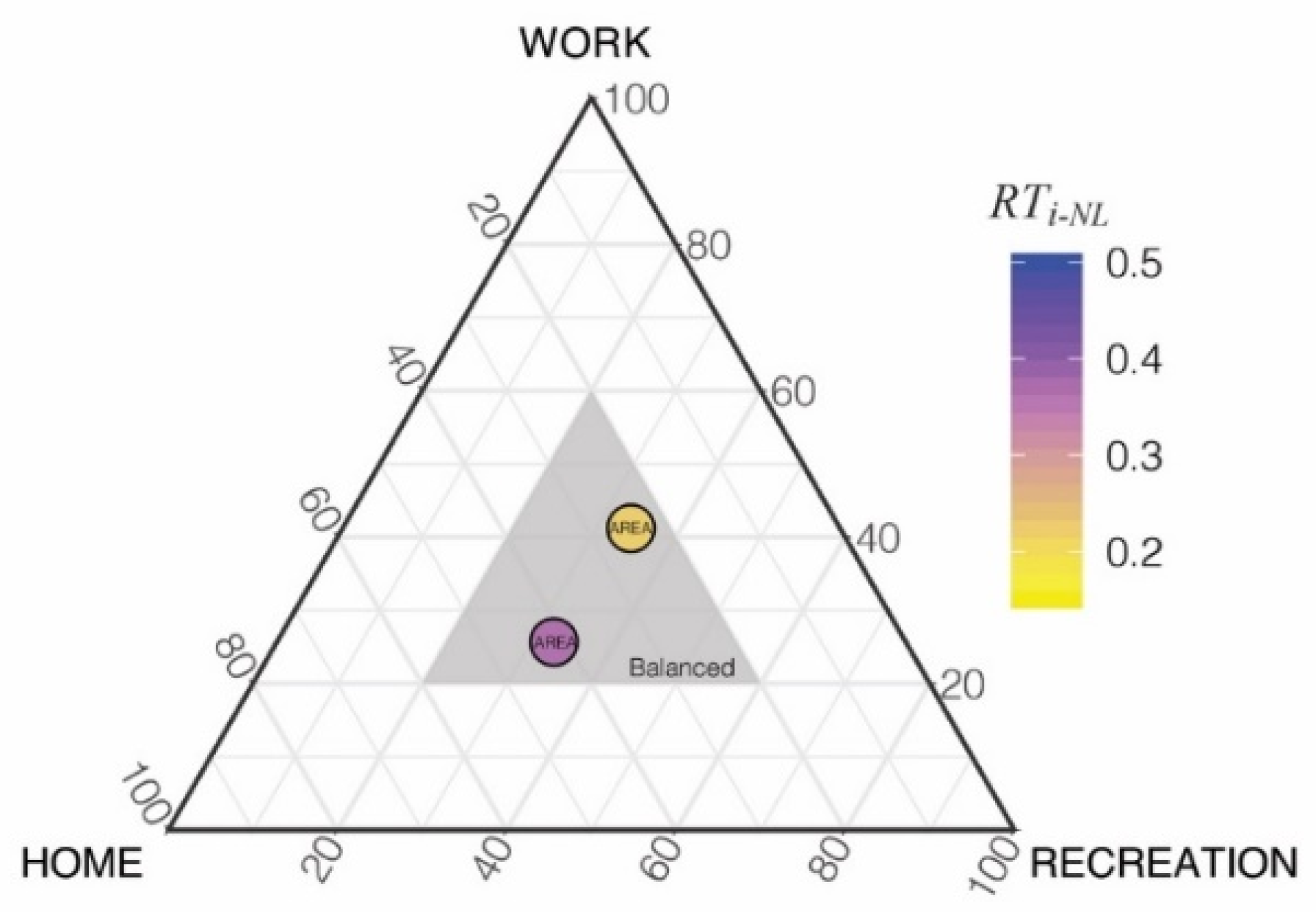
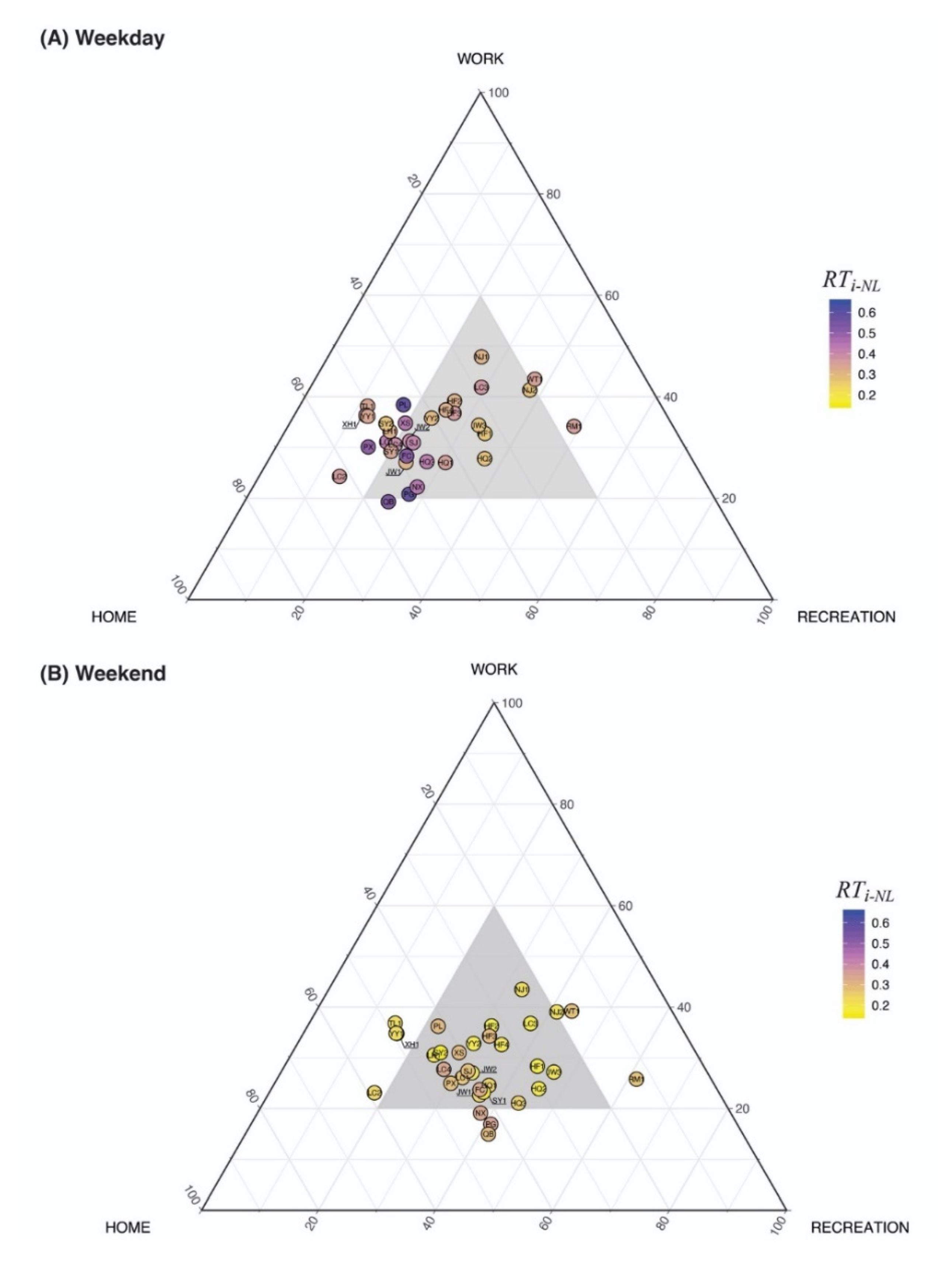

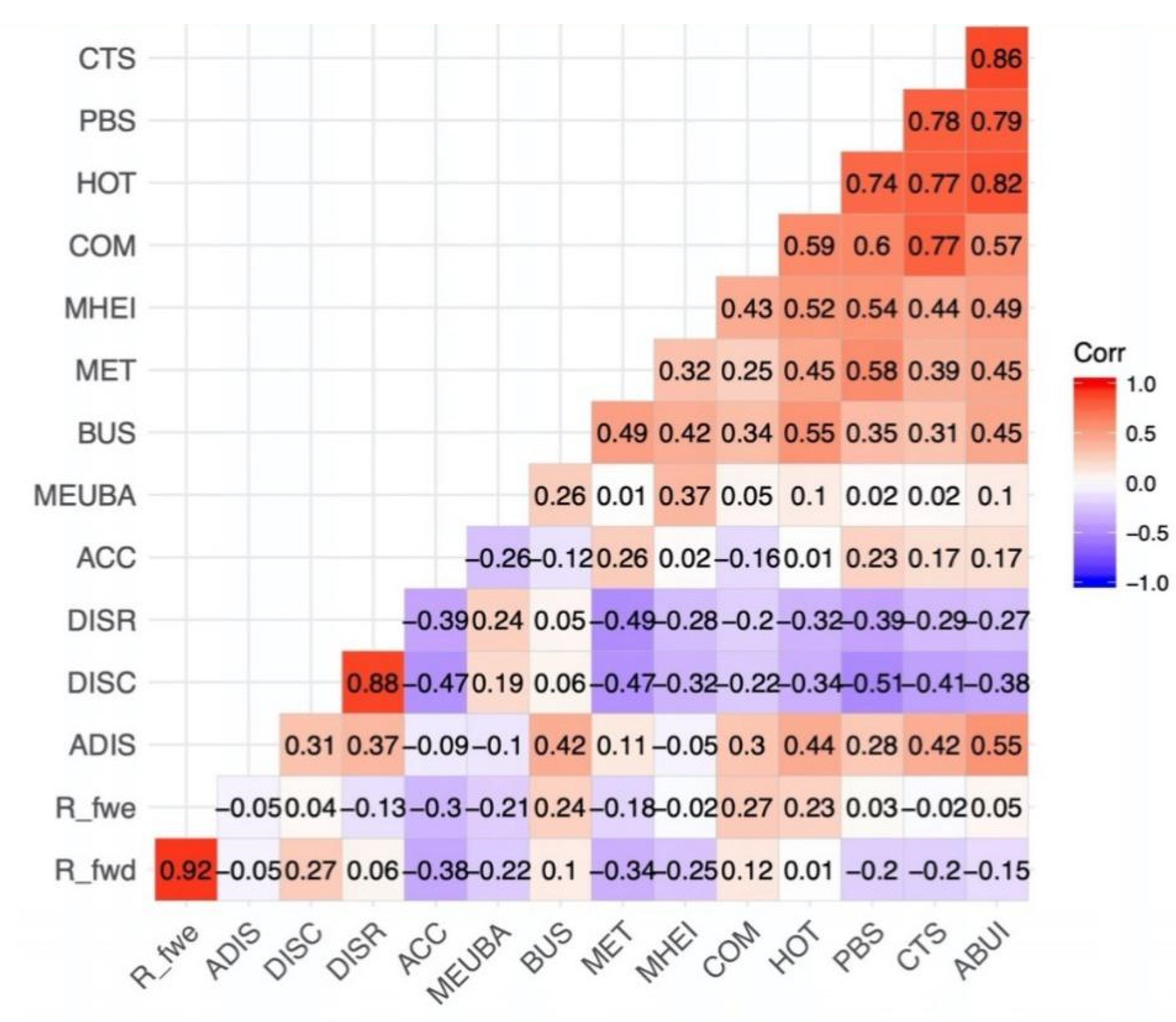
| Name | Subsets | Construction Time |
|---|---|---|
| Hengshan-Fuxin | HF-01/02/03/04 | 1919–1941 |
| Hongqiao Road | HQ-01/02/03 | 20th Century |
| Jiangwan | JW-01/02/03 | 1930–1940 |
| Laochengxiang | LC-01/02/03/04 | 16th Century |
| Longhua Road | LH-01 | 15th Century |
| Renmin Square | RM-01 | 1860–1941 |
| Nanjingxi Road | NJ-01/02 | 1899–1941 |
| Shanyin Road | SY-01/02 | 1900–1925 |
| Tilanqiao | TL-01 | 1939–1945 |
| The Bund | WT-01 | 1900–1941 |
| Xinhua Road | XH-01 | 1925–1941 |
| Yuyuan Road | YY-01/02 | 1919–1941 |
| Pudong Gaoqiao | PG | 10th Century |
| Pudong Xinchang | PX | 10th Century |
| Minhang Qibao | QB | 11th Century |
| Xujin Panlong | PL | 16th Century |
| Jiading Nanxiang | NX | 6th Century |
| Sijing Guzhen | SJ | 10th Century |
| Hangtou Xiasha | XS | 8th Century |
| Songjiang Fucheng | FC | 13th Century |
| Predictor Variable | Variable Name | Units | Mean | S. D | Min | Max |
|---|---|---|---|---|---|---|
| Urban Scale Features | ||||||
| Distance to City Center | DISC | m | 8807.1 | 8464.6 | 123.8 | 33,172.9 |
| Distance to Huangpu River | DISR | m | 6315.2 | 6123.9 | 437.2 | 23,602.8 |
| Local Facilities and Functions | ||||||
| Number of Metro Station | MET | / | 1.7 | 1.7 | 0.0 | 6.0 |
| Number of Bus Station | BUS | / | 28.3 | 18.5 | 1.0 | 80.0 |
| Number of Commercial | COM | / | 9.2 | 8.1 | 0.0 | 28.0 |
| Number of Public Service | PBS | / | 8.7 | 9.2 | 0.0 | 32.0 |
| Number of Hotel | HOT | / | 21.4 | 16.1 | 0.0 | 67.0 |
| Number of Catering Service | CTS | / | 378.5 | 327.1 | 1.0 | 1230.0 |
| Built Environment Features | ||||||
| Area of the District | km2 | km2 | 1.1 | 0.7 | 0.3 | 2.2 |
| Area of the Buildings | ABUI | km2 | 1.3 | 0.9 | 1.5 | 3.8 |
| Mean Height | MHEI | m | 5.0 | 1.5 | 2.3 | 9.6 |
| Medium of Urban Block Area | MEUBA | m2 | 236.4 | 64.7 | 120.6 | 353.3 |
| Accessibility | ACC | / | 147,624,518.6 | 113,685,533.3 | 9,688,160.2 | 443,784,990.3 |
| Area | HF1 | HF2 | HF3 | HF4 | HQ1 | HQ2 | HQ3 | JW1 | JW2 | JW3 | LC1 | LC2 | LC3 | LC4 |
|---|---|---|---|---|---|---|---|---|---|---|---|---|---|---|
| Weekday | B | B | B | B | B | B | B | B | B | B | B | - | B | B |
| Weekend | B | B | B | B | B | B | B | B | B | B | B | - | B | B |
| Final Label | AB | AB | AB | AB | AB | AB | AB | AB | AB | AB | BS | AU | AB | AB |
| LH1 | NJ1 | NJ2 | RM1 | SY1 | SY2 | TL1 | WT1 | XH1 | YY1 | YY2 | PG | PX | QB | |
| Weekday | - | B | B | - | B | - | - | - | - | - | B | B | - | - |
| Weekend | B | B | - | - | B | B | B | - | - | - | B | - | B | - |
| Final Label | BS | AB | BS | AU | AB | BS | BS | AU | AU | AU | AB | BS | BS | AU |
| PL | NX | SJ | XS | FC | ||||||||||
| Weekday | - | B | B | - | B | |||||||||
| Weekend | B | - | B | B | B | |||||||||
| Final Label | BS | BS | AB | BS | AB | |||||||||
| Predictor Variables | Balanced Sometimes/Always Balanced | Always Unbalanced/Always Balanced | ||||
|---|---|---|---|---|---|---|
| Coefficient (β2) | Standard Error | exp (β2) | Coefficient (β3) | Standard Error | exp (β3) | |
| Intercept | 0.1836 *** | 1.1891 × 10−17 | 1.2015 | 0.2478 | 1.4485 × 10−17 | 1.2812 |
| Urban Scale Features | ||||||
| DISC | 0.0005 *** | 7.7224 × 10−14 | 1.0005 | 0.0003 *** | 6.0957 × 10−14 | 1.0002 |
| Local Facilities and Functions | ||||||
| BUS | −0.0493 *** | 2.3312 × 10−16 | 0.9518 | −0.0059 *** | 3.5163 × 10−16 | 0.9941 |
| MET | 0.0757 *** | 2.2123 × 10−17 | 1.0786 | 0.3052 *** | 2.7608 × 10−17 | 1.3569 |
| COM | 0.2293 *** | 8.8610 × 10−17 | 1.2577 | 0.0937 *** | 8.1426 × 10−17 | 1.0982 |
| PBS | 0.2494 *** | 1.2127 × 10−16 | 1.2833 | 0.0679 *** | 7.9312 × 10−17 | 1.0702 |
| Built Environment Features | ||||||
| ADIS | −0.0782 *** | 1.0784 × 10−15 | 0.9340 | −0.0635 *** | 8.2946 × 10−16 | 0.9384 |
| MHEI | −0.1866 *** | 5.9841 × 10−17 | 0.8298 | 0.7114 *** | 7.7382 × 10−17 | 2.0368 |
| MEUBA | −0.0077 *** | 2.6637 × 10−15 | 0.9923 | −0.0087 *** | 3.3376 × 10−15 | 0.9913 |
| ACC | 5.3720 × 10−9 | 3.1679 × 10−9 | 1.0000 | −3.9948 × 10−9 | 3.0882 × 10−9 | 1.0000 |
| Non-local tourists’ ratio () | ||||||
| weekend | 0.0061 *** | 2.6775 × 10−18 | 1.0061 | 0.0711 *** | 3.2859 × 10−18 | 1.0737 |
| Always Unbalanced/Balanced Sometimes | (Intercept) | DISC | BUS | MET | COM | PBS |
|---|---|---|---|---|---|---|
| 1.0664 | 0.9997 | 1.0444 | 1.2580 | 0.8732 | 0.8340 | |
| ADIS | MHEI | MEUBA | ACC | Weekend | ||
| 1.0047 | 2.4547 | 0.9990 | 1.0000 | 1.0672 |
| Reviews | Classified as AB | Classified as BS | Classified as AU |
|---|---|---|---|
| AB | 17 | 1 | 0 |
| BS | 1 | 8 | 2 |
| AU | 0 | 2 | 2 |
Publisher’s Note: MDPI stays neutral with regard to jurisdictional claims in published maps and institutional affiliations. |
© 2021 by the authors. Licensee MDPI, Basel, Switzerland. This article is an open access article distributed under the terms and conditions of the Creative Commons Attribution (CC BY) license (https://creativecommons.org/licenses/by/4.0/).
Share and Cite
Shi, C.; Liu, M.; Ye, Y. Measuring the Degree of Balance between Urban and Tourism Development: An Analytical Approach Using Cellular Data. Sustainability 2021, 13, 9598. https://doi.org/10.3390/su13179598
Shi C, Liu M, Ye Y. Measuring the Degree of Balance between Urban and Tourism Development: An Analytical Approach Using Cellular Data. Sustainability. 2021; 13(17):9598. https://doi.org/10.3390/su13179598
Chicago/Turabian StyleShi, Cheng, Mengyang Liu, and Yu Ye. 2021. "Measuring the Degree of Balance between Urban and Tourism Development: An Analytical Approach Using Cellular Data" Sustainability 13, no. 17: 9598. https://doi.org/10.3390/su13179598
APA StyleShi, C., Liu, M., & Ye, Y. (2021). Measuring the Degree of Balance between Urban and Tourism Development: An Analytical Approach Using Cellular Data. Sustainability, 13(17), 9598. https://doi.org/10.3390/su13179598






